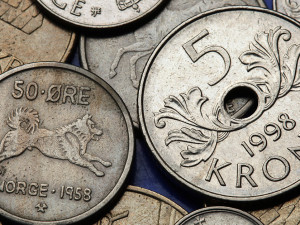
At the time of writing, the Swedish krona (SEK) is experiencing a period of weakness, being undervalued compared to its economic fundamentals.
Over a number of years, the krona has fallen to record lows against major currencies like the euro and the US dollar. As of the 27th of February 2025, the USD/SEK exchange rate is at 10.67, a historically weak position for the currency. Analysts have identified some key factors for the krona’s poor performance, with the International Monetary Fund as well as Sweden’s central bank assessing that the krona is undervalued by around 10%, based on the country’s economic fundamentals in strong public finance and competitiveness, for example. The krona has been particularly sensitive to external global financial conditions, as well as to rising domestic troubles with household debt and property prices. As a floating currency, this sensitivity is to be expected. Through analysis of the currency and country’s economic fundamentals, as well as exploring the strategies of the Riksbank (Sweden’s central bank), we can thoroughly assess the current state of the Swedish krona and make informed predictions about its future outlook.
What short-term events have contributed to the Swedish krona’s weakness?
Through a combination of long-term structural problems and short-term global shocks, the Swedish krona’s decline can be attributed to the following factors:
Global Financial Uncertainty
After Russia’s invasion of Ukraine and the aftereffects of the COVID-19 pandemic, global financial markets have experienced increased uncertainty. One downstream effect of this is a strengthening of the US dollar and the depreciation of currencies from smaller, open economies like Sweden.
Contrasting Interest Rates
After the US Federal Reserve made aggressive interest rate hikes, the difference between the rates of the US and Sweden has made the dollar more attractive to investors. While the Riksbank has also raised rates, it hasn’t matched the level of the US Federal Reserve, leading to a depreciation of the krona.
Weak Risk Sentiment
When traders’ appetite for risk diminishes, they will tend toward ‘safer’ investments that prioritise the protection of capital. This has led investors to move away from Swedish assets, causing the krona’s value to fall.

What are the Long-Term structural issues stifling the krona?
Analysts believe that the krona is undervalued by 10-20%, despite some strong economic fundamentals. Some of the long-term issues include:
Capital Flow from Pension Reform
After changes were made to the Swedish pension system, investments abroad have been made. The lower demand for domestic currency, therefore leads to a depreciation of its value.
Debt Level
High private sector debt levels and slow growth in GDP have further undermined confidence in the Swedish economy, which adds to currency woes.
Historical Trends
Further structural issues are suggested by the persistence of the long-term downward trend over the past decade – even during periods of relative economic strength for Sweden.
The Riksbank Hedging Strategy
A hedging strategy implemented by the Riksbank has been designed to reduce the currency risk in its foreign exchange reserves. The primary goal has been to reduce the risks on the Riksbank’s balance sheets caused by changes in exchange rates. Deciding to hedge approximately 25% of its FX reserves, the Riksbank began selling large amounts of foreign currency against the SEK over four months. Since its implementation, the krona has shown relative strength compared to other G10 countries. However, there are a number of potential risks associated with this strategy:
Limited Sustained Impact
The hedging program amounted to 8 billion USD and 2 billion EUR. Compared to the daily turnover of SEK, these amounts are relatively small. This puts a limit on the program’s ability to have a sustained impact on the value of the krona, making it unlikely to make major trend changes.
Transparency Exploitation
The Riksbank publishes all hedging operation data, allowing market participants to estimate how much ‘firepower’ is left. Traders may anticipate the limits of the strategy, and begin to speculate against the krona.
Credibility Risk
While the strategy has been labelled as a measure for risk management, some have interpreted the measures to be a ‘covert foreign exchange intervention’. This could harm the credibility of the Riksbank if markets view it as being inconsistent with stated monetary policy objectives.
Loss Risk
If the krona significantly appreciates, the Riksbank may face substantial losses in their FX reserves. If the appreciation reaches 2022 levels, for example, the losses could extend to 65 billion SEK.
Policy Conflicts
The Debt Office of Sweden is currently reducing their currency exposure by selling SEK. As both this and the currency hedging operation are Government initiatives, the mixed signals may spook the market, as well as reducing the effectiveness of both policies.

What are the long-term projections for the Swedish krona?
Analysts suggest that the Swedish krona is likely to strengthen due to current undervaluations, in combination with the strong economic fundamentals of Sweden. However, it is difficult to predict the exact timings and extent of the appreciation. As global economic uncertainty eases, combined with a narrowing of the interest rate differential between Sweden and the US, the krona is expected to benefit as a result. However, certain challenges will need to be overcome, including the betting on continued weakness of the krona from traders, which will delay its recovery.
Conclusion
The Swedish krona’s current weakness is due to a combination of many factors, as we have explored. While external factors such as geopolitical instability and contrasting interest rate policies have contributed to its depreciation, deeper ingrained structural issues like capital outflows and high private sector debt have further stifled its growth. The Riksbank’s hedging strategy has provided some short-term support, but its long-term effectiveness remains uncertain due to transparency risks and potential internal policy conflicts.
Despite these challenges, analysts maintain that the krona is undervalued and could strengthen over time as economic conditions stabilise and global financial uncertainty eases. For now, the krona’s future will largely depend on Sweden’s ability to navigate economic headwinds and maintain confidence in its monetary policies.
As always, for currency news and insight into the world of currency, make sure to stay up to date with our Expert Analysis, as well as our daily Market Commentary.
Caleb Hinton
Caleb is a writer specialising in financial copy. He has a background in copywriting, banking, digital wallets, and SEO – and enjoys writing in his spare time too, as well as language learning, chess and investing.



